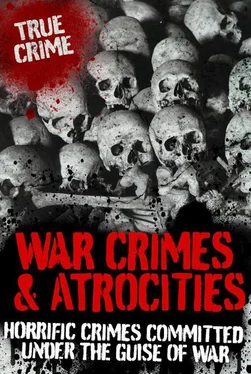No Japanese leader has so far agreed to make this kind of apology. Instead, in its defence, the Japanese government points to the monetary compensation it has made to the victims of war crimes, in compliance with the Potsdam Declaration of 1945, which specified the terms of Japan’s surrender to the Allies. They also point to the setting up of the Asian Women’s Fund in 1995, an organization that aims to compensate women forced into prostitution during World War II.
THE ROLE OF HIROHITO
Interestingly, although there is a general view in Europe and the USA that the Japanese refuse to speak about what happened during the war, in recent years there has been a great deal of debate about the issue of war crimes within the country. The view that the Japanese military were only acting in the way they had been trained to do, and were part of a highly authoritarian culture that demanded cruelty towards the enemy as a mark of obedience and loyalty to the emperor, has come under attack. Many critics, both on the left and right, now argue that the Japanese leaders of the time acted in a criminal manner, against the moral and legal constraints of the time, and that the Allies were right to pursue the matter in the courts after the war.
The actions of Emperor Hirohito during World War II have also come under scrutiny, with some commentators arguing that he should have abdicated. Others believe that it was not his moral duty to do so, and that as a figurehead, he was forced to abide by decisions of his ministers. According to the majority view, the real culpability for the war crimes lay with the leading figures in the Japanese Cabinet and military High Command, most of whom were tried and convicted at the Tokyo trials.
1995–99

The case of Dusko Tadic is an important one in that it was the first case to be brought before the International Criminal Tribunal for Yugoslavia (ICTY). The ICTY was set up in May 1993 by the UN Security Council for the sole purpose of bringing to trial those responsible for violations of international humanitarian law in the territory of the former Yugoslavia. Its main aim is to bring justice to the victims of the Bosnian war, which saw ethnic cleansing, genocide and many other serious war crimes.
It is probably hard for people to digest, but the 20th century has seen four times as many civilian victims of war crimes and crimes against humanity than there were soldiers killed in all the international wars combined. When the world cried ‘never again’ after the atrocities of the Nazi holocaust, it was hoped that the prosecution of the Nazi leaders for their monstrous actions at Nuremberg, would put a stop to such barbarity – but this was not to be the case. Between the years 1992 and 1995, atrocities were committed by all sides against all sectors of the population in Bosnia– Herzegovina. Worst of all these atrocities was the gender-selective mass executions of civilians and systematic brutality, particularly against the Muslim population. This is the trial of just one man who was guilty of breaching international law and his complete disregard for his fellow human beings.
BRIEF BACKGROUND
Dusko Tadic was born on 1 October, 1955, in the town of Kozarac. He was born into a military family, his father having been a hero in World War II. His mother had been a detainee at Jasenovac, which was the largest concentration and extermination camp in Croatia during World War II. Tadic became a member of the Serbian Democratic Party (SDS) in 1990.
The SDS attacked the town of Prijedor on 30 April, 1992, with the aid of both the police and military forces. This resulted in the party taking control of Prijedor and Kozarac, which was approximately 10 km (6 miles) to the east. The attack on Kozarac lasted for two days and killed approximately 800 civilians, which was a large proportion of the 4,000 inhabitants of the town. Once the SDS were in control of the town, they started to raid any homes of the non-Serb population and expelled them from the area. They were made to leave with whatever possessions they could carry and walk to camps at Omarska, Keraterm and Trnopolje, and they were subjected to harsh treatment on their already arduous journey. When they arrived at the camps their hardships were to continue as they faced the most appalling conditions.
Tadic was accused of not only having supported the troops in their attack, but being an active member of the SDS and the paramilitary forces and having actively taking part in all stages of the attack on Kozarac. He was further held responsible for the mis-treatment of the civilians in the camps, particularly at Omarska. Before the conflict started there were approximately 50,000 Muslims and 6,000 Croats living in the district, but following the ethnic cleansing their numbers were reduced to around 6,000 and 3,000 respectively. Any who remained in the area were forced to live under the most abject conditions.
BROUGHT TO TRIAL
After the cleansing campaign, Tadic was elected president of the local council of the SDS on 15 August, 1992. The following year he was sent to the war zone near Gradacac, but he lasted only one day before going into hiding to avoid being drafted into military service. In August 1993, Tadic went to Nuremberg and then on to Munich where he lived until 12 February, 1994. He was arrested by the Germany police and held in custody until April 1995, when he was transferred to the ICTY in The Hague to face trial.
The trial by the ICTY was the first international war crimes trial since Nuremberg. Security was tight, and the state-of-the-art courtroom at The Hague was sealed off from the spectators’ gallery by bulletproof glass. Television crews were given licence to film, and were placed around the room ready to beam the proceedings to closed-circuit monitors in the building and outside in the press tent. To avoid any language problems there were simultaneous video and audio translations into English, French and Serbo-Croat, and a nearly instantaneous transcript of the proceedings appeared on a monitor that was available to everyone taking part in the trial. The same monitor was used to show any available documentary evidence.
Tadic first appeared before the court on 26 April, 1995, and pleaded not guilty to the 34 counts of crimes against humanity. Three of the counts were withdrawn shortly after the trial started, which brought more than 150 witnesses to give evidence. Tadic, who claimed he was a victim of mistaken identity, knew his fate rested with a three-judge panel headed by Gabrielle Kirk McDonald, a former US federal judge from Texas. He faced a maximum life sentence if found guilty.
Almost two years later, on 7 May, 1997, Dusko Tadic was found guilty of crimes against humanity on six counts and of violations of the laws or customs of war on five counts. The prosecution made it clear that despite the fact that Tadic’s victims had already suffered the horrors of a two-day artillery bombardment, he still sent them to camps where he was fully aware of the horrific conditions that awaited them. They felt that Tadic had a flagrant disregard for human life and the suffering of others and that he should bear full responsibility for the deaths and the extremely violent and cruel way in which the detainees were treated.
When the sentence was read out it said:
…that the crimes consisted of killings, beatings and forced transfer by Dusko Tadic as principal or as an accessory, as well as his participation in the attack on the town of Kozarac in opstina Prijedor, in northwestern Bosnia.
Читать дальше













